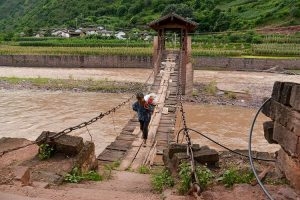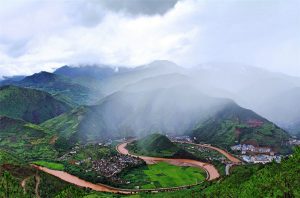Pijiang River in Yunlong County, Dali

Chinese Name: 沘江
Chinese Pinyin: Pi Jiang
English Name: Pijiang River in Yunlong County, Dali
Type: river
Area: 2447.4 square kilometers
Opening Hours: all day
Ticket: free
Location: Yunlong County, Dali
Pijiang River
Pijiang is the main branch of upper Lancang River, originating from the Qingyanshi Mountain of Lanping in Nujiang. Enjoying an area of 2447.4 square kilometers, Pijiang crosses Lanping County and Yunlong County. Many ethnic groups live along the river. Compared with the colorful ethnic culture, it is famous for the rich mineral resources. Pijiang is known as the museum of ancient bridges because of the diverse bridges on the Pijiang River.
Environment
The largest lead-zinc mining area in the country is located in Lanping County, the upper reaches of the Pijiang River.

It is an important non-ferrous metal production base in Yunnan Province. Due to the long-term large-scale disordered group mining, pollution control and supervision measures have not been well implemented. The pollution level of the Lancang River became increasingly serious, which eventually led to the loss of the production and living water functions of the main stream of the Lancang River, which seriously affected the sustainable development of the coastal urban and rural economy and society, and had a serious impact on the production and life of the people in the Lancang River Basin.
Main Attraction
Yunlong County Minjiang Ancient Bridge Group(云龙县沘江古桥梁群)
Yunlong’s preserved bridges range from the oldest primitive strops and rattan bridges to modern steel truss bridges which can form a bridge museum. In 2013, Pijiang Ancient Bridge Group was listed as the seventh batch of key cultural relics protection units in the country.
The stone arch bridge appeared earlier. These bridges are not only beautiful in form, but also strong in structure. These long-standing, well-formed and solid stone arch bridges still play an important role today. Therefore, it is a precious legacy that shows the industrious wisdom and excellence of the ancient workers.
Yunlong Natural Taiji Eight-Diagram (云龙太极八卦图)

To the north of Yunlong county, there’s a river named Bijiang River(沘江), whose riverbed forms a shape of Taiji symbol. Because in Han Dynasty, Yunlong county was called “Bisu ” county, the Bijiang River, in fact, means “a river in Bisu”. With a whole length of 173 km, the river curves into a big “S” shape when passing here, forming a natural spectacle of Taiji symbol. In this natural spectacle, the Zhuangping dam in the north and Lian-jing-ping dam in the south constitute the two fish-like patterns representing “yin” and “yang” respectively in Taiji symbol, making it more vivid. What is called “Taiji Symbol” is a symbol used by ancient Chinese to explain natural phenomena in the universe, showing the the law of unity of opposites between yin and yang. Normally, there are also Eight Trigrams arranged in octagon around the symbol.
Useful Travel Tips
When the weather is fine in Dali, the sunshine is heated, and ultraviolet light is strong. People should avoid direct sunlight, and the sun hat preparation is required during outdoor activities, a pair of sunglasses will make you comfortable in the trip.

 7 Days GolfingTour
7 Days GolfingTour
 8 Days Group Tour
8 Days Group Tour
 8 Days Yunnan Tour
8 Days Yunnan Tour
 7 Days Shangri La Hiking
7 Days Shangri La Hiking
 11 Days Yunnan Tour
11 Days Yunnan Tour
 6 Days Yuanyang Terraces
6 Days Yuanyang Terraces
 11 Days Yunnan Tour
11 Days Yunnan Tour
 8 Days South Yunnan
8 Days South Yunnan
 7 Days Tea Tour
7 Days Tea Tour
 8 Days Muslim Tour
8 Days Muslim Tour
 12 Days Self-Driving
12 Days Self-Driving
 4 Days Haba Climbing
4 Days Haba Climbing
 Tiger Leaping Gorge
Tiger Leaping Gorge
 Stone Forest
Stone Forest
 Yunnan-Tibet
Yunnan-Tibet
 Hani Rice Terraces
Hani Rice Terraces
 Kunming
Kunming
 Lijiang
Lijiang
 Shangri-la
Shangri-la
 Dali
Dali
 XishuangBanna
XishuangBanna
 Honghe
Honghe
 Kunming
Kunming
 Lijiang
Lijiang
 Shangri-la
Shangri-la
 Yuanyang Rice Terraces
Yuanyang Rice Terraces
 Nujiang
Nujiang
 XishuangBanna
XishuangBanna
 Spring City Golf
Spring City Golf
 Snow Mountain Golf
Snow Mountain Golf
 Stone Mountain Golf
Stone Mountain Golf















